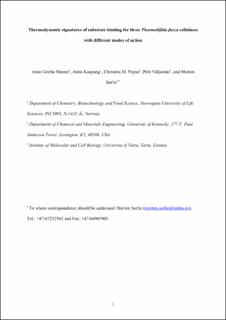| dc.contributor.author | Hamre, Anne Grethe | |
| dc.contributor.author | Kaupang, Anita | |
| dc.contributor.author | Payne, Christina M. | |
| dc.contributor.author | Väljamäe, Priit | |
| dc.contributor.author | Sørlie, Morten | |
| dc.date.accessioned | 2020-09-28T13:33:48Z | |
| dc.date.available | 2020-09-28T13:33:48Z | |
| dc.date.created | 2019-06-14T09:31:46Z | |
| dc.date.issued | 2019 | |
| dc.identifier.citation | Biochemistry. 2019, 58 (12), 1648-1659. | en_US |
| dc.identifier.issn | 0006-2960 | |
| dc.identifier.uri | https://hdl.handle.net/11250/2680019 | |
| dc.description.abstract | The enzymatic breakdown of recalcitrant polysaccharides is achieved by synergistic enzyme cocktails of glycoside hydrolases (GHs) and accessory enzymes. Many GHs are processive, meaning that they stay bound to the substrate between subsequent catalytic interactions. Cellulases are GHs that catalyze the hydrolysis of cellulose [β-1,4-linked glucose (Glc)]. Here, we have determined the relative subsite binding affinity for a glucose moiety as well as the thermodynamic signatures for (Glc)6 binding to three of the seven cellulases produced by the bacterium Thermobifida fusca. TfCel48A is exo-processive, TfCel9A endo-processive, and TfCel5A endo-nonprocessive. Initial hydrolysis of (Glc)5 and (Glc)6 was performed in H218O enabling the incorporation of an 18O atom at the new reducing end anomeric carbon. A matrix-assisted laser desorption ionization time-of-flight mass spectrometry analysis of the products reveals the intensity ratios of otherwise identical 18O- and 16O-containing products to provide insight into how the substrate is placed during productive binding. The two processive cellulases have significant binding affinity in subsites where products dissociate during processive hydrolysis, aligned with a need to have a pushing potential to remove obstacles on the substrate. Moreover, we observed a correlation between processive ability and favorable binding free energy, as previously postulated. Upon ligand binding, the largest contribution to the binding free energy is desolvation for all three cellulases as determined by isothermal titration calorimetry. The two endo-active cellulases show a more favorable solvation entropy change compared to the exo-active cellulase, while the two processive cellulases have less favorable changes in binding enthalpy compared to the nonprocessive TfCel5A. | en_US |
| dc.language.iso | eng | en_US |
| dc.rights | Attribution-NonCommercial-NoDerivatives 4.0 Internasjonal | * |
| dc.rights.uri | http://creativecommons.org/licenses/by-nc-nd/4.0/deed.no | * |
| dc.title | Thermodynamic Signatures of Substrate Binding for Three Thermobifida fusca Cellulases with Different Modes of Action | en_US |
| dc.type | Peer reviewed | en_US |
| dc.type | Journal article | en_US |
| dc.description.version | acceptedVersion | en_US |
| dc.source.pagenumber | 1648-1659 | en_US |
| dc.source.volume | 58 | en_US |
| dc.source.journal | Biochemistry | en_US |
| dc.source.issue | 12 | en_US |
| dc.identifier.doi | 10.1021/acs.biochem.9b00014 | |
| dc.identifier.cristin | 1704852 | |
| cristin.unitcode | 192,12,0,0 | |
| cristin.unitname | Kjemi, bioteknologi og matvitenskap | |
| cristin.ispublished | true | |
| cristin.fulltext | postprint | |
| cristin.qualitycode | 1 | |

